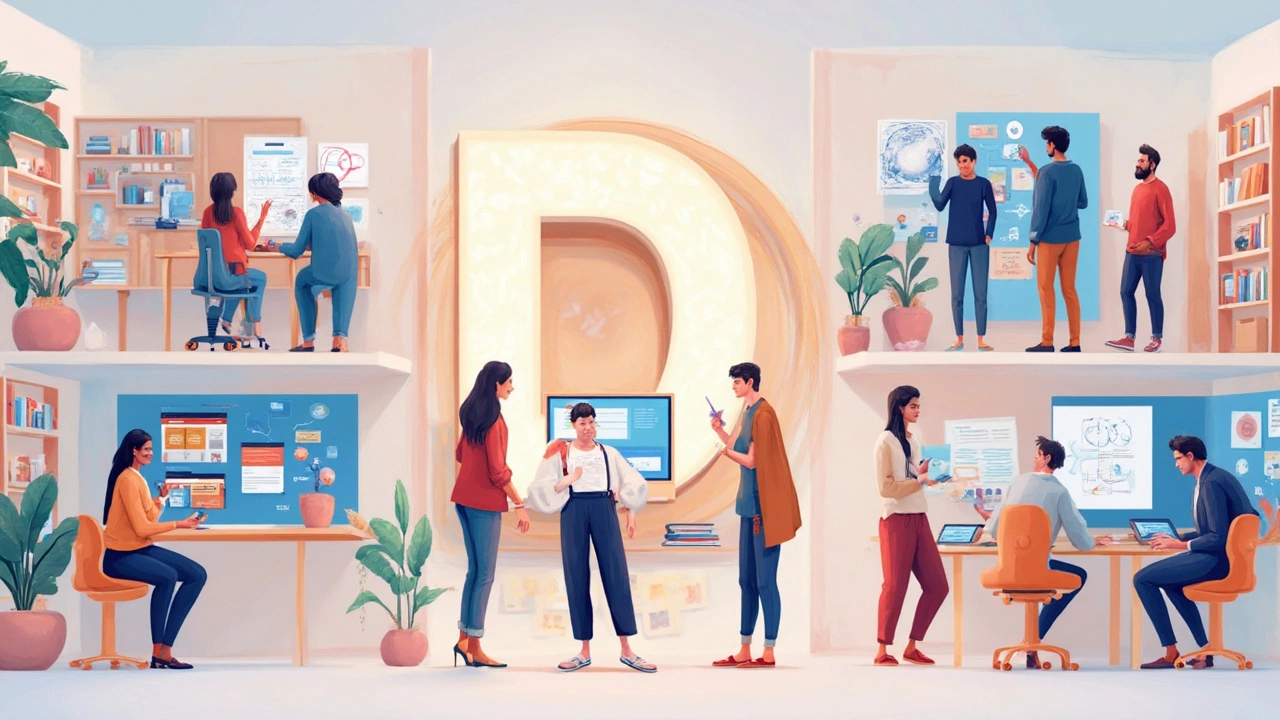Ever wonder why some businesses seem to have a magic touch when it comes to coming up with fresh, new ideas? It’s not just luck or chance. A lot comes down to understanding a pretty straightforward concept: the 4 D's of innovation. If you're aiming to shake things up or just keep up in this chaotic world, knowing about these can be a game-changer.
So, what are these 4 D's? We're talking about Discover, Design, Develop, and Deploy. It sounds simple, but each step is packed with tasks that really matter. Let's start with Discover. Think of it like a treasure hunt, but instead of gold, you're on the lookout for opportunities and unmet needs. It's like finding out what people need before they even know themselves.
Moving on to Design, this is where you take all those ideas you've unearthed and start crafting them into something real. It’s a lot like putting together the pieces of a puzzle, except here, you're creating a roadmap that’ll guide your next steps. Get ready, because after that, it’s Develop time. This is where things start getting serious, as you build and refine your solution, making sure it’s ready to hit the real world.
- The Pillars of Innovation
- Discovery: Uncovering Opportunities
- Design: Crafting Solutions
- Development: Bringing Ideas to Life
- Deployment: Making an Impact
- Lessons from Real-World Innovators
The Pillars of Innovation
Imagine building a house without a solid foundation. Spooky, right? The same goes for innovation. The key to successful innovation lies in understanding and utilizing the 4 D's: Discover, Design, Develop, and Deploy. Think of these D's as the sturdy pillars holding up your awesome idea house.
First up is Discovery. This is where the magic begins. It’s about digging into the world around you to find those hidden gems—opportunities waiting to be transformed into groundbreaking ideas. It's like going on a treasure hunt but armed with curiosity and research tools instead of a map and shovel.
Next is Design. Here, creativity kicks in full throttle. It’s not just throwing ideas together; it’s about crafting them with purpose. Imagine trying to fit together a puzzle where the pieces only fit if you’ve done the right groundwork. This stage is all about creating a prototype—a working model of your idea—to iron out wrinkles before moving forward.
- Define the Problem: Clearly identify what you want to solve or address.
- Generate Ideas: Brainstorm a variety of solutions. Don't hold back.
- Explore Feasibility: Check what’s realistically doable with the resources at hand.
Rolling over to Development, this is where you bring your designs to life. This phase is all about testing and refining, ensuring your idea is ready to make its grand debut. Make sure you foster collaboration across teams. After all, two heads are better than one.
Finally, we have Deployment. This is where your idea meets the real world. It’s like sending your kids to their first day of school—you hope they’re ready, but you need to be prepared to learn and adapt. It's important to gather feedback and use that info to tweak and improve.
These pillars, when understood and applied right, can really drive meaningful and effective innovation. Remember, it's a cycle, too. Once you deploy, you might head back to discover new needs or designs. This dynamism is what keeps innovation ever relevant and forward-moving.
Discovery: Uncovering Opportunities
The first step toward innovation is all about discovery. It’s like being a detective—but for ideas. The goal here is to find those elusive gaps in the market. Think of it as figuring out what people need or what could make their lives better. It’s kind of like a treasure hunt, with hidden gems of possibilities.
To get started, pay close attention to what's happening around you. Keeping your ear to the ground can uncover trends that are just starting to emerge. For instance, the shift towards remote work has opened doors for businesses offering collaboration tools. Being aware of such shifts can give you a leg up.
Another powerful way to discover opportunities is by tapping into customer feedback. Ever noticed how some big brands revolutionize themselves just by listening to what their customers say? Gathering feedback gives direct insight into what's lacking in your product or the market in general.
Now, you might wonder how detailed this process can get. Here’s a quick look at how some companies dive deep during discovery:
- Conducting surveys to gather broad input from potential users.
- Analyzing competitor strengths and weaknesses to spot gaps.
- Observing customer behavior to identify unmet needs.
Another cool trick is using data analytics. There's a sea of information out there, and if you can harness it, you're halfway there. Look for patterns or anomalies in data. They often point to opportunities waiting to be seized.
| Method | Effectiveness |
|---|---|
| Customer Surveys | High |
| Competitor Analysis | Medium |
| Data Analytics | High |
This discovery phase is fundamental to the 4 D's of innovation. By dedicating time and resources to uncovering opportunities, businesses position themselves to move forward with ideas that aren't just creative—they're effective. It’s about finding the right idea at the right time.
Design: Crafting Solutions
Design is where the magic starts to happen. Once you’ve discovered those golden opportunities, it's time to shape them into real, tangible solutions. Think of this phase as a bridge connecting wild ideas to practical realities. It's all about taking what you’ve found during discovery and stirring it into something actionable and creative.
At this stage, visualization is key. You need to develop prototypes and sketches. These aren't meant to be final versions but are helpful to visualize the concept and identify any potential hiccups. The idea is to mix creativity with practicality, ensuring that solutions are both innovative and feasible.
Let’s break this down into steps:
- Brainstorming: Gathering your team to suss out every possible angle. No idea is too crazy here, and the more input you get, the better. The aim is to generate a diverse set of ideas that can address the identified opportunities.
- Storyboarding: This helps in creating a narrative around your concepts. It’s handy for visualizing the user journey and refining the context in which your solution exists. It's like mapping out a movie scene by scene.
- Prototyping: Forget about flawless perfection at this stage. Your prototypes just need to reflect the core idea. Whether a quick digital mock-up or a basic physical model, having something to showcase brings ideas to life.
- Feedback Loop: Once you've got prototypes, gather feedback. This can be from your team, potential users, or even your pet dog, Bruno. The aim is to pinpoint areas that need adjusting before diving into development.
Effective solution design doesn't just stop at aesthetics or functionality. It's also about how smoothly you can tweak and elevate these solutions based on real-world tests and feedback loops. This iterative process ensures that by the time you're ready to develop, you’re working with something smart, sleek, and fully aligned with user needs.
For businesses in the innovation game, mastering the

Development: Bringing Ideas to Life
Alright, so you've got your design blueprint ready. Now comes the exciting part—developing these ideas into something tangible. It's like building a house. You've got the plan, so now it's time to gather the bricks, the tools, and, of course, the team that'll put it all together.
Development is where ideas meet action. You're not just thinking about solutions anymore; you're actually creating them. One crucial step here is prototyping, where you build a working model or a version of your product to test out. This model helps in figuring out what works and what doesn't before finalizing the details. Remember, it's all about learning and tweaking as necessary.
A big part of this phase is iteration. You make sure to test, gather feedback, and then polish and perfect based on what you find. Sometimes it takes several rounds to get things just right, but hey, that's part of the journey and ensures a solid final product.
It’s important to keep your team tight-knit and open to ideas during development. Our furry friend Bruno might not be on the innovation team, but having open communication can be as uplifting and reassuring as a good puppy cuddle. Swapping thoughts and tackling challenges together can push the project forward smoothly.
Speaking of smooth sailing, did you know that companies that focus more on development phases often see a 30% higher success rate when launching new innovations? This shows just how crucial a well-executed development phase is in the innovation process.
As things start taking shape, don't underestimate the power of small details. Every tiny element plays a part in the bigger picture, so make sure you're thoughtful about each decision you make.
By working through this developing phase with patience and care, you're setting the stage for a smooth transition into actually deploying your solution into the real world, which we'll dive into next.
Deployment: Making an Impact
This is where all your hard work gets put to the test. After you've gone through the grind of discovery, design, and development, it's time to deploy your innovation into the real world. Think of deployment as the moment when your thoughtful ideas finally start to breathe life and make a real difference.
But how do you ensure a successful deployment? It begins with understanding your audience and their needs. Tailor your strategies to fit their preferences and expectations. It's like throwing a surprise party—you need to know what will delight and excite your audience.
A good deployment strategy often involves a soft launch—essentially, releasing your product or service to a small segment of your audience to gather feedback. This step helps iron out any kinks and offers invaluable insights before going all out. For instance, companies like Netflix often test features with a subset of users to gauge reactions before a full-scale launch.
Another important aspect of deployment is communication. Engaging with your audience throughout the launch process helps build anticipation and ensures clarity. Create buzz through social media, newsletters, or special events. Let people know why your innovation matters and how it can make their lives better.
Lastly, measuring success is crucial. Keep track of key performance indicators (KPIs) to evaluate how well your innovation is performing. Are users loving it, or is there room for improvement? Stay tuned into feedback loops to continuously refine and optimize your offering.
Lessons from Real-World Innovators
When we talk about learning from the best, big names like Steve Jobs and Elon Musk often come to mind. Why? Because they’ve both made their mark by applying the principles of the 4 D's of innovation. These lessons aren't textbook jargon; they're real insights with practical benefits.
Let's start with Steve Jobs. The creation of the iPhone was no accident or spur-of-the-moment idea. Apple spent time in the Discover phase, understanding what people wanted—something sleek, multi-functional, and easy to use. Jobs famously said,
"Innovation distinguishes between a leader and a follower."By truly knowing the user's needs, Apple designed groundbreaking solutions that changed the way we communicate.
Then there's Elon Musk and the story of Tesla. The whole world knows about electric cars, but before Tesla made them cool, they were just a niche idea. Musk invested heavily in the Development phase, refining technology, cutting costs, and scaling production. His commitment turned what seemed like a geeky dream into a global phenomenon.
Even smaller companies have lessons to share. Consider the success story of the virtual meeting platform, Zoom. When the world went remote, Zoom had already gone through the 4 D's, ready to Deploy a user-friendly solution that perfectly fit the sudden global demand.
In all these examples, the secret sauce isn't just about flashy tech or a massive budget. It’s about following through each stage of the 4 D's diligently and being open to change. Whether you’re in tech, retail, or any other sector, applying these lessons can help you navigate the crazy landscape of modern business and get a genuine edge.





